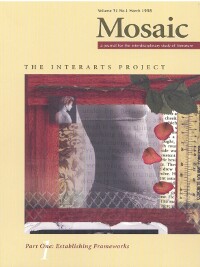Issue 31.1
Overview

Special Issue: The Interarts Project I: Establishing Frameworks
Published: March 1998
View the issue introduction or see the issue summary and contents below.
8 essays, totalling 192 pages
$14.95 CAD
The first of four parts of Mosaic’s special Interarts Project, this issue asks how the arts are interrelated. Looking at multi-media artists and interactive arts, this issue features essays on word, image, and narrative relations in illuminated manuscripts; the grounds for comparing composite artists such as William Blake, Carlo Gesualdo, and Georges Seurat; abduction and semiotic theory as a possible language for interarts discourse; how music defines the adaptive mood of The Turn of the Screw; the correspondence between the Ballets Russes’s Parade and T.S. Eliot’s The Waste Land; art’s utility to neuroscience and human cognition; the stylistic and narrative similarities of Dutch still-life painting and the personal essay; and the sensorial riding nature of the word as visual or verbal media.
Genesis and Narratology: The Challenge of Medieval Illustrated TextsMary C. Olson A study of the interactions between verbal and pictorial elements in the Old English Illustrated Hexateuch reveals the ways in which both modes of expression indicate narrative temporality through representations of duration, repetition, simultaneity, and causality, and the importance of temporal relationships as a fundamental aspect of narrative. | |
Locating the Anomalous: Gesualdo, Blake, and SeuratBrent E. Whitted Historical periodization tends to cluster together artists who “mastered” the stylistic rules defined by “disciplinary” aesthetic traditions. By enlisting a critical vocabulary that moves beyond limitations imposed by historical specificity, this essay examines the origins and nature of artwork whose “composite” structures frustrate periodization and separation of the arts. | |
The Multi-Talented Artist: Toward an Abductive ApproachKent W. Hooper After surveying the kinds and limitations of previous attempts to discuss similarities between works produced in different media by the same artist, this essay attempts to construct a sounder base by enlisting the semiotic theories of Charles Sanders Peirce and Umberto Eco. Particular focus is on the conjunction of chance and experience that is entailed in the concept of “abductive reasoning.” | |
Film Music as Sister Art: Adaptations of The Turn of the ScrewMonika Brown Viewing film adaptation as a mode of creative interpretation, this essay explores the way that music can complement visual and verbal elements in shaping and communicating a director’s response to a literary text. Specific focus is on Henry James’s The Turn of the Screw and four differing contemporary cinematic treatments of the enigmatic novella. | |
The Great Parade: Cocteau, Picasso, Satie, Massine, Diaghilev—and T.S. EliotNancy D. Hargrove The astounding synergism in the arts in the early decades of the 20th century is powerfully demonstrated in the striking correspondences between two of the most experimental and daring works of the time, the Ballets Russes’ ballet Parade and T.S. Eliot’s The Waste Land. | |
The Arts, Emotion, and Current Research in NeuroscienceChristine P. Watling According to Susanne Langer, reasoning includes “the process of building up insight into relations too complex to be grasped by direct inspection,” and in this way artworks can lead to knowledge about the patterns of higher cognitive function. Studies in neuroscience support both this conclusion and Langer’s contention that art “clarifies and organizes intuition itself.” | |
Prosaic Rhetoric in Still-Life Paintings and Personal EssaysLouise Z. Smith Using sociolinguistic theories of “prosaics” and the “dialogic,” this essay explores the rhetoric which characterizes Dutch still-life painting and the personal essay. Both employ such features as rotation, series, arc, and gestures of intimacy to create a coherent, angular form which conjoins speaker and listener in vigorous yet tentative explorations of ordinary life. | |
Thawing the Frozen Image/Word: Vernacular Postmodern AestheticsW. F. Garrett-Petts and Donald Lawrence This essay seeks to define an emerging postmodern aesthetic, one tied to notions of language’s material presence, through an exploration of the frozen words trope. Using Canadian pictorial art as a general foil, the essay focuses on how Canadian postmodernist writer Robert Kroetsch engages in a vernacular interrogation of visual/verbal boundaries. |